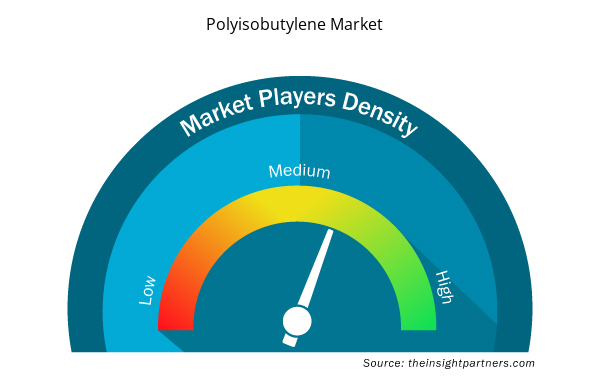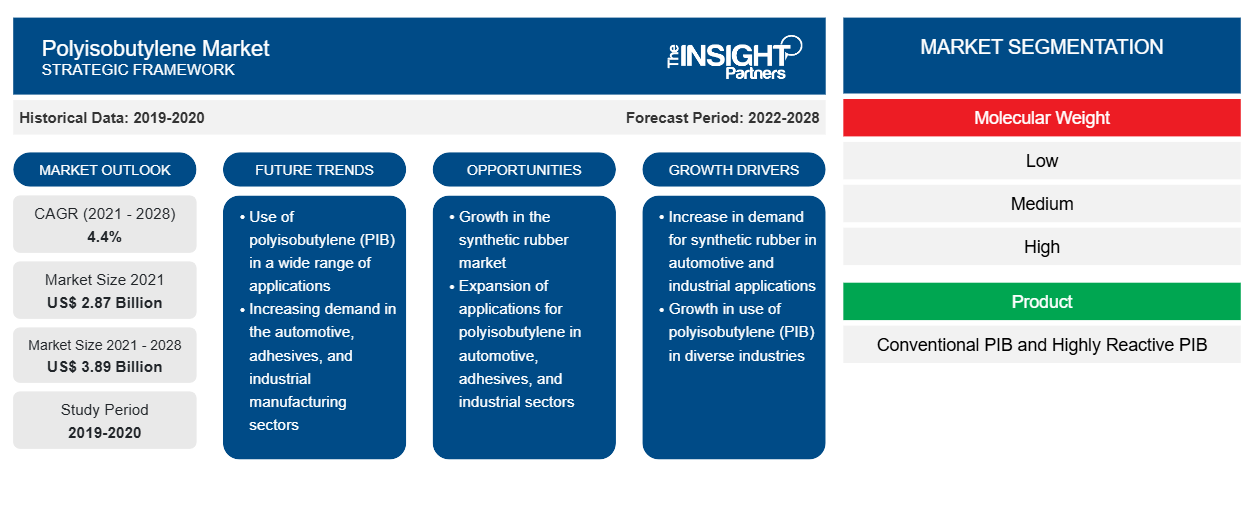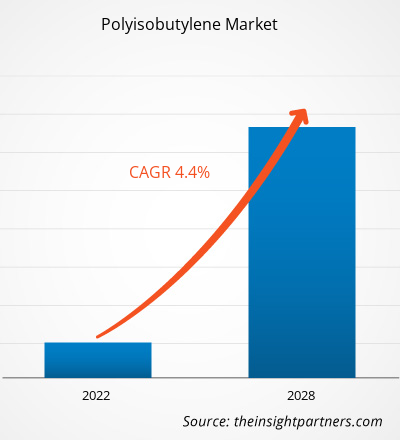[Rapport de recherche] Le marché du polyisobutylène était évalué à 2 871,14 millions USD en 2021 et devrait atteindre 3 891,16 millions USD d'ici 2028 ; il devrait croître à un TCAC de 4,4 % de 2021 à 2028.
Le polyisobutylène (PIB) est un élastomère ou un caoutchouc synthétique. En fonction du poids moléculaire, le marché est segmenté en faible, moyen et élevé. Il s'agit d'un liquide visqueux polyvalent, non toxique et blanc comme l'eau. Le polyisobutylène peut augmenter l'adhérence, fournir une imperméabilité à l'eau, améliorer l'indice de viscosité et fournir une excellente isolation électrique.
En 2020, l'Amérique du Nord détenait la plus grande part des revenus du marché mondial du polyisobutylène . La demande croissante de diverses applications, telles que le transport, l'agrochimie, l'électricité et les adhésifs, stimule la croissance du marché en Amérique du Nord. Le polyisobutylène est de plus en plus utilisé dans les secteurs du transport, de l'alimentation et de la construction car il offre une faible perméabilité aux gaz, une excellente résistance à la traction, une résistance chimique élevée et une rigidité accrue.
Personnalisez ce rapport en fonction de vos besoins
Vous bénéficierez d'une personnalisation gratuite de n'importe quel rapport, y compris de certaines parties de ce rapport, d'une analyse au niveau des pays, d'un pack de données Excel, ainsi que d'offres et de remises exceptionnelles pour les start-ups et les universités.
- Obtenez les principales tendances clés du marché de ce rapport.Cet échantillon GRATUIT comprendra une analyse de données, allant des tendances du marché aux estimations et prévisions.
Impact de la pandémie de COVID-19 sur le marché du polyisobutylène
La pandémie de COVID-19 a radicalement modifié le statut du secteur des produits chimiques et des matériaux et a eu un impact négatif sur la croissance du marché du polyisobutylène. L'industrie mondiale des produits chimiques et des matériaux est l'une des principales industries qui souffrent de graves perturbations dues à la pandémie, telles que des ruptures de la chaîne d'approvisionnement, des annulations d'événements technologiques et des fermetures de bureaux. Les interdictions de voyager à l'échelle mondiale imposées par les pays d'Europe, d'Asie et d'Amérique du Nord affectent les collaborations commerciales et les opportunités de partenariat. Tous ces facteurs devraient affecter négativement l'industrie de l'électronique et des produits chimiques et des matériaux, ce qui entrave la croissance de divers marchés liés à ces industries. Cependant, alors que les économies prévoient de relancer leurs opérations, la demande de polyisobutylène devrait augmenter à l'échelle mondiale. La demande de polyisobutylène des secteurs des lubrifiants industriels et des additifs de lubrification en aval a commencé à augmenter avec la reprise des activités commerciales et la levée des mesures de confinement à l'échelle mondiale. Perspectives du marché
L'industrie automobile va alimenter la croissance du marché pendant la période de prévision
Pour l'industrie automobile, la performance des moteurs pour remplir leurs fonctions quotidiennes est importante. L'industrie automobile est le marché clé pour plusieurs types d' additifs pour carburant depuis de nombreuses années. La part des automobiles a toujours été supérieure à celle des autres segments de marché des additifs pour carburant en raison du manque d'alternatives efficaces aux combustibles fossiles et de l'augmentation de l'économie de la classe moyenne. L'importance relative de l'aviation pour les additifs pour carburant a augmenté ces dernières années, ce qui a finalement fait augmenter la demande de polyisobutylène.
Informations sur les applications
En fonction de l'application, le marché mondial du polyisobutylène est segmenté en pneus, lubrifiants industriels et additifs de lubrification, additifs pour carburants, adhésifs et produits d'étanchéité, et autres. Le segment des lubrifiants industriels et des additifs de lubrification détenait la plus grande part du marché en 2020. Le polyisobutylène (PIB) réagit avec l'anhydride maléique pour former du polyisobutényl-succinimide (PIBSA), un élément de base pour les dispersants dans les huiles lubrifiantes et les détergents dans les carburants. Son autre variante, le polyisobutylène-succinimide (PIBSI), dérivé du polyisobutylène (PIB), agit comme un émulsifiant antioxydant dans les fluides de travail des métaux solubles et comme un élément de base des additifs de lubrification. Le PIB brûle également plus proprement, ce qui le rend idéal pour une utilisation dans les huiles de moteurs à deux temps et les applications marines où les lubrifiants sont soumis aux gaz de soufflage agressifs des énormes moteurs diesel.
BASF SE, Braskem SA, Daelim Industrial Petrochemical Division, Ineos AG, Infineum International Limited., Kothari Petrochemicals., Sibur Holding PJSC, Kemat Polybutenes, The Lubrizol Corporation et TPC Group comptent parmi les principaux acteurs du marché mondial du polyisobutylène. Les acteurs opérant sur le marché sont très concentrés sur le développement d'offres de produits de haute qualité et innovantes pour répondre aux exigences des clients.
Aperçu régional du marché du polyisobutylène
Les tendances régionales et les facteurs influençant le marché du polyisobutylène tout au long de la période de prévision ont été expliqués en détail par les analystes d’Insight Partners. Cette section traite également des segments et de la géographie du marché du polyisobutylène en Amérique du Nord, en Europe, en Asie-Pacifique, au Moyen-Orient et en Afrique, ainsi qu’en Amérique du Sud et en Amérique centrale.

- Obtenez les données régionales spécifiques au marché du polyisobutylène
Portée du rapport sur le marché du polyisobutylène
| Attribut de rapport | Détails |
|---|---|
| Taille du marché en 2021 | 2,87 milliards de dollars américains |
| Taille du marché d'ici 2028 | 3,89 milliards de dollars américains |
| Taux de croissance annuel moyen mondial (2021-2028) | 4,4% |
| Données historiques | 2019-2020 |
| Période de prévision | 2022-2028 |
| Segments couverts | Par poids moléculaire
|
| Régions et pays couverts | Amérique du Nord
|
| Leaders du marché et profils d'entreprises clés |
|
Densité des acteurs du marché du polyisobutylène : comprendre son impact sur la dynamique commerciale
Le marché du polyisobutylène connaît une croissance rapide, tirée par la demande croissante des utilisateurs finaux en raison de facteurs tels que l'évolution des préférences des consommateurs, les avancées technologiques et une plus grande sensibilisation aux avantages du produit. À mesure que la demande augmente, les entreprises élargissent leurs offres, innovent pour répondre aux besoins des consommateurs et capitalisent sur les tendances émergentes, ce qui alimente davantage la croissance du marché.
La densité des acteurs du marché fait référence à la répartition des entreprises ou des sociétés opérant sur un marché ou un secteur particulier. Elle indique le nombre de concurrents (acteurs du marché) présents sur un marché donné par rapport à sa taille ou à sa valeur marchande totale.
Les principales entreprises opérant sur le marché du polyisobutylène sont :
- BASF SE
- Braskem SA
- Division pétrochimique industrielle de Daelim
- Ineos AG
- Infineum International Limited
Avis de non-responsabilité : les sociétés répertoriées ci-dessus ne sont pas classées dans un ordre particulier.

- Obtenez un aperçu des principaux acteurs du marché du polyisobutylène
Rapports en vedette
- Tendances industrielles progressistes sur le marché du polyisobutylène pour aider les acteurs à développer des stratégies efficaces à long terme
- Stratégies de croissance des entreprises adoptées par les marchés développés et en développement
- Analyse quantitative du marché du polyisobutylène de 2019 à 2028
- Estimation de la demande mondiale en polyisobutylène
- Analyse des cinq forces de Porter pour illustrer l'efficacité des acheteurs et des fournisseurs opérant dans l'industrie
- Développements récents pour comprendre le scénario concurrentiel du marché
- Tendances et perspectives du marché, ainsi que facteurs qui stimulent et freinent la croissance du marché du polyisobutylène
- Aide à la prise de décision en mettant en évidence les stratégies de marché qui sous-tendent l'intérêt commercial, conduisant à la croissance du marché
- La taille du marché du polyisobutylène à différents niveaux
- Aperçu détaillé et segmentation du marché, ainsi que de la dynamique de l'industrie du polyisobutylène
- Taille du marché du polyisobutylène dans diverses régions avec des opportunités de croissance prometteuses
Marché du polyisobutylène
Par poids moléculaire
- Faible
- Moyen
- Haut
- Produit
- PIB conventionnel
- PIB hautement réactif
Application
- Pneus
- Lubrifiants industriels et additifs pour lubrifiants
- Additifs pour carburant
- Adhésifs et produits d'étanchéité
- Autres
Secteur d'utilisation finale
- Industriel
- Nourriture
- Autres
Profils d'entreprise
- BASF SE
- Braskem SA
- Division pétrochimique industrielle de Daelim
- Ineos AG
- Infineum International Limitée.
- Polybutènes Kemat
- Produits pétrochimiques de Kothari
- Sibur Holding PJSC
- La société Lubrizol
- Groupe TPC
- Analyse historique (2 ans), année de base, prévision (7 ans) avec TCAC
- Analyse PEST et SWO
- Taille du marché Valeur / Volume - Mondial, Régional, Pays
- Industrie et paysage concurrentiel
- Ensemble de données Excel



Report Coverage
Revenue forecast, Company Analysis, Industry landscape, Growth factors, and Trends

Segment Covered
This text is related
to segments covered.

Regional Scope
North America, Europe, Asia Pacific, Middle East & Africa, South & Central America

Country Scope
This text is related
to country scope.
Questions fréquemment posées
Polyisobutylene (PIB) are also used as substitutes for bright stock owing to their advantages such as better viscosity indices and more oxidative and hydrolytic stability. PIB also burn cleaner, making them ideal for use in two-stroke engines oils and marine applications where lubricants are subjected to harsh blow-by gases from huge diesel engines. PIBs are often used in industrial gear oils and have long been used as thickeners in automotive gear oils. The ubiquitous use of polyisobutylene in industrial gear oils is expected to have a positive influence on the polyisobutylene industry.
The major players operating in the global polyisobutylene market are BASF SE, Braskem SA, Daelim Industrial Petrochemical Division, Ineos AG, Infineum International Limited, Kemat Polybutenes, Kothari Petrochemicals, Sibur Holding PJSC, The Lubrizol Corporation, and TPC Group; among many others.
In 2018, the polyisobutylene market was predominant in North America at the global level. North America region has a well-established automotive and transport industry. The increase in the production of automotive propels the demand for polyisobutylene. Therefore, increased demand for automobiles and infrastructure developments in the US and Canada are expected to fuel the polyisobutylene market during the forecast period.
Trends and growth analysis reports related to Chemicals and Materials : READ MORE..
The List of Companies - Polyisobutylene Market
- BASF SE
- Braskem SA
- Daelim Industrial Petrochemical Division
- Ineos AG
- Infineum International Limited
- Kemat Polybutenes
- Kothari Petrochemicals
- Sibur Holding PJSC
- The Lubrizol Corporation
- TPC Group
The Insight Partners performs research in 4 major stages: Data Collection & Secondary Research, Primary Research, Data Analysis and Data Triangulation & Final Review.
- Data Collection and Secondary Research:
As a market research and consulting firm operating from a decade, we have published and advised several client across the globe. First step for any study will start with an assessment of currently available data and insights from existing reports. Further, historical and current market information is collected from Investor Presentations, Annual Reports, SEC Filings, etc., and other information related to company’s performance and market positioning are gathered from Paid Databases (Factiva, Hoovers, and Reuters) and various other publications available in public domain.
Several associations trade associates, technical forums, institutes, societies and organization are accessed to gain technical as well as market related insights through their publications such as research papers, blogs and press releases related to the studies are referred to get cues about the market. Further, white papers, journals, magazines, and other news articles published in last 3 years are scrutinized and analyzed to understand the current market trends.
- Primary Research:
The primarily interview analysis comprise of data obtained from industry participants interview and answers to survey questions gathered by in-house primary team.
For primary research, interviews are conducted with industry experts/CEOs/Marketing Managers/VPs/Subject Matter Experts from both demand and supply side to get a 360-degree view of the market. The primary team conducts several interviews based on the complexity of the markets to understand the various market trends and dynamics which makes research more credible and precise.
A typical research interview fulfils the following functions:
- Provides first-hand information on the market size, market trends, growth trends, competitive landscape, and outlook
- Validates and strengthens in-house secondary research findings
- Develops the analysis team’s expertise and market understanding
Primary research involves email interactions and telephone interviews for each market, category, segment, and sub-segment across geographies. The participants who typically take part in such a process include, but are not limited to:
- Industry participants: VPs, business development managers, market intelligence managers and national sales managers
- Outside experts: Valuation experts, research analysts and key opinion leaders specializing in the electronics and semiconductor industry.
Below is the breakup of our primary respondents by company, designation, and region:

Once we receive the confirmation from primary research sources or primary respondents, we finalize the base year market estimation and forecast the data as per the macroeconomic and microeconomic factors assessed during data collection.
- Data Analysis:
Once data is validated through both secondary as well as primary respondents, we finalize the market estimations by hypothesis formulation and factor analysis at regional and country level.
- Macro-Economic Factor Analysis:
We analyse macroeconomic indicators such the gross domestic product (GDP), increase in the demand for goods and services across industries, technological advancement, regional economic growth, governmental policies, the influence of COVID-19, PEST analysis, and other aspects. This analysis aids in setting benchmarks for various nations/regions and approximating market splits. Additionally, the general trend of the aforementioned components aid in determining the market's development possibilities.
- Country Level Data:
Various factors that are especially aligned to the country are taken into account to determine the market size for a certain area and country, including the presence of vendors, such as headquarters and offices, the country's GDP, demand patterns, and industry growth. To comprehend the market dynamics for the nation, a number of growth variables, inhibitors, application areas, and current market trends are researched. The aforementioned elements aid in determining the country's overall market's growth potential.
- Company Profile:
The “Table of Contents” is formulated by listing and analyzing more than 25 - 30 companies operating in the market ecosystem across geographies. However, we profile only 10 companies as a standard practice in our syndicate reports. These 10 companies comprise leading, emerging, and regional players. Nonetheless, our analysis is not restricted to the 10 listed companies, we also analyze other companies present in the market to develop a holistic view and understand the prevailing trends. The “Company Profiles” section in the report covers key facts, business description, products & services, financial information, SWOT analysis, and key developments. The financial information presented is extracted from the annual reports and official documents of the publicly listed companies. Upon collecting the information for the sections of respective companies, we verify them via various primary sources and then compile the data in respective company profiles. The company level information helps us in deriving the base number as well as in forecasting the market size.
- Developing Base Number:
Aggregation of sales statistics (2020-2022) and macro-economic factor, and other secondary and primary research insights are utilized to arrive at base number and related market shares for 2022. The data gaps are identified in this step and relevant market data is analyzed, collected from paid primary interviews or databases. On finalizing the base year market size, forecasts are developed on the basis of macro-economic, industry and market growth factors and company level analysis.
- Data Triangulation and Final Review:
The market findings and base year market size calculations are validated from supply as well as demand side. Demand side validations are based on macro-economic factor analysis and benchmarks for respective regions and countries. In case of supply side validations, revenues of major companies are estimated (in case not available) based on industry benchmark, approximate number of employees, product portfolio, and primary interviews revenues are gathered. Further revenue from target product/service segment is assessed to avoid overshooting of market statistics. In case of heavy deviations between supply and demand side values, all thes steps are repeated to achieve synchronization.
We follow an iterative model, wherein we share our research findings with Subject Matter Experts (SME’s) and Key Opinion Leaders (KOLs) until consensus view of the market is not formulated – this model negates any drastic deviation in the opinions of experts. Only validated and universally acceptable research findings are quoted in our reports.
We have important check points that we use to validate our research findings – which we call – data triangulation, where we validate the information, we generate from secondary sources with primary interviews and then we re-validate with our internal data bases and Subject matter experts. This comprehensive model enables us to deliver high quality, reliable data in shortest possible time.


 Obtenez un échantillon gratuit pour ce rapport
Obtenez un échantillon gratuit pour ce rapport